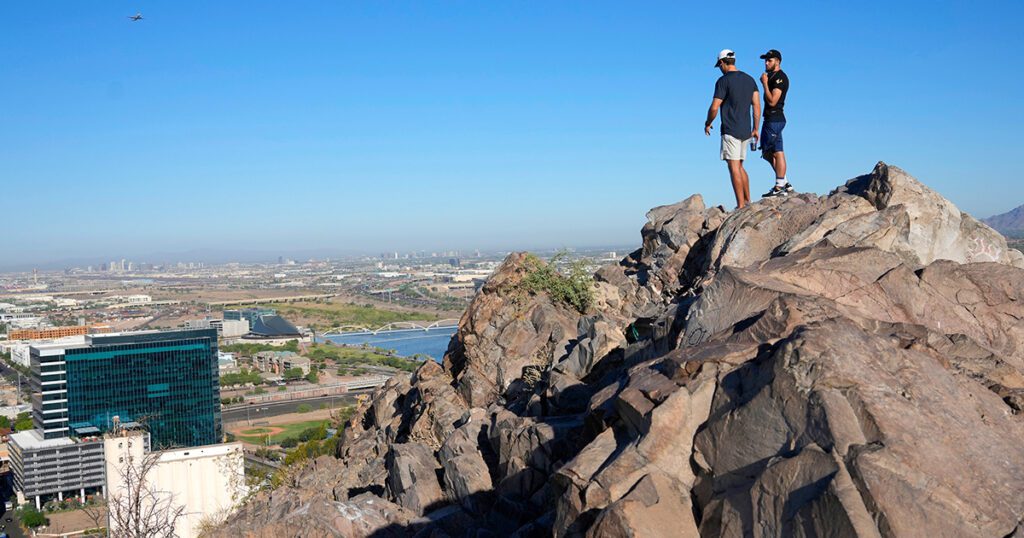Judy Schwiebert grew up in western Phoenix in the 1960s, when the now-booming city was what she describes as “a pretty small town” and the biggest event of the year was the three-day rodeo.
Everything stopped for the rodeo parade, as horse-drawn carriages, marching bands and dancers made their way through town. Schools closed for the full three days, recalls Schwiebert, who is now a Democratic state representative. In 1969, the county was still home to fewer than 1 million people, less than one-quarter the size it is today.
“Over the years here I’ve seen it grow and grow,” she said.
The area became a magnet for conservatives like John Kavanagh, a retired New York Port Authority Police officer. After 20 years of policing, Kavanagh and his wife went west, to Maricopa County.
Kavanagh was like a lot of other people who moved to Arizona in the 1990s — middle-class folks fleeing colder places and what they saw as economic and political dysfunction around them — for a sunny, affordable, and what they perceived as a cleaner city.
“A lot of people came from those other cities and they don’t want a repeat of what they left,” Kavanagh said.
In 1993, the county’s population was 2.3 million. Republicans dominated the state legislature and Maricopa County politics. As a young state of transplants, it was easier than in other places for new arrivals to enter Arizona politics. Kavanagh was elected to the state’s House of Representatives in 2006. Now he is serving his first term in the state Senate; the county’s population has nearly doubled since his arrival, and its politics have changed.
Arizona now has a Democratic governor, elected in 2022. Both its U.S. senators — Mark Kelly and Kyrsten Sinema — were elected as Democrats, though Sinema has since become an independent.
Kavanagh attributes the county’s leftward shift to a wide array of factors — from societal changes he sees as driven by the media and academia to people moving to Arizona for higher-paying jobs that require more education.
“Hopefully there’s a point where people look and see what the result will be if that trend continues,” Kavanagh said, predicting a strong November for his Republican Party. “Just look to L.A., look to New York, you know, look to Seattle. That’s where the continuing shift left will still occur. So let’s do a hard stop and maybe go a few steps back to the right.”
Clearly, many who made the move to Maricopa over the past few decades were not like Kavanagh. The county’s conservative, low-tax approach attracted businesses as well as individuals, and those companies then attracted workers who sometimes were different from the older transplants to Arizona.
Condos and apartments give way to the Phoenix skyline Tuesday, Sept. 24, 2024, in Tempe, Ariz. (AP Photo/Ross D. Franklin)
South Mountain Park and Preserve and nearby subdivision, Phoenix, Thursday, June 27, 2024. (AP Photo/Serkan Gurbuz)
South Mountain Park and Preserve and nearby subdivision, Phoenix, Thursday, June 27, 2024. (AP Photo/Serkan Gurbuz)
Kevin Henderson moved to Maricopa in 2010 at age 23, after living in Chicago and Portland, Oregon. A Democrat who works in catering, he was pleasantly surprised by life in a then-red state and its residents’ live-and-let-live attitude.
“The people were very friendly,” said Henderson, now 37. “We are fortunate that, with such an eclectic group of people, we are very, understanding and accepting of other people’s views.”
At the same time that people like Henderson came from other places inside the United States, increased migration to Arizona from Mexico also prompted political change.
In the 1990s, President Bill Clinton’s administration strengthened California’s border, pushing illegal migration to Arizona, which already had a robust Hispanic population. Immigration quickly became a political flashpoint, leading many in the growing Latino population in Maricopa legally to feel that Republicans were demonizing them.
The biggest shift came in 2010, when Arizona’s Republican-controlled legislature passed a law allowing local police to stop people they suspected of being in the country illegally. The U.S. Supreme Court overturned the law, but it energized the state’s Latinos to organize against Republicans.
The law, which opponents dubbed “Show Me Your Papers,” was the harshest anti-immigrant law in the nation, and it changed Arizona politics, Latino activist Garcia said. It led to boycotts and protests. Nationally and internationally, people knew about Republican Sheriff Joe Arpaio — who pushed for the law — and his crime sweeps aimed at immigrants.
Republicans swept the state in 2010 and their hammerlock on Maricopa County seemed likely to continue even amid growing Latino dissatisfaction.
But that would change, as a new GOP leader emerged.
Source link : http://www.bing.com/news/apiclick.aspx?ref=FexRss&aid=&tid=67221ffa3903433db14a0e52e1fd6742&url=https%3A%2F%2Fapnews.com%2Farticle%2Felection-voting-maricopa-arizona-a36ebb6884a9d87406157b10e84365cc&c=2509236276457883581&mkt=en-us
Author :
Publish date : 2024-10-29 22:59:00
Copyright for syndicated content belongs to the linked Source.
